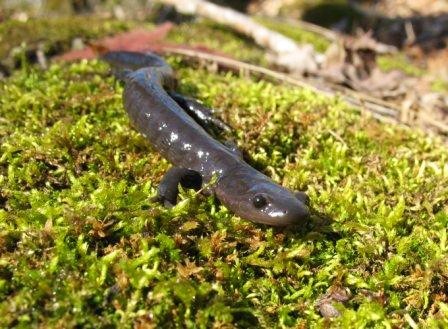MOUNT NEMO OMB DECISION
Key Issue: Species at risk
 “JEFF WINS THE DAY”: The Nelson Aggregate limestone quarry that was proposed for Burlington in 2004 was denied in October 2012 by the Joint ERT/OMB. The denial was a first on the Niagara Escarpment. The primary reason for the Joint Board’s denial was to protect the Jefferson Salamander, an endangered species, and its habitats. The lessons are in ‘how’ this issue became the primary deciding factor:
“JEFF WINS THE DAY”: The Nelson Aggregate limestone quarry that was proposed for Burlington in 2004 was denied in October 2012 by the Joint ERT/OMB. The denial was a first on the Niagara Escarpment. The primary reason for the Joint Board’s denial was to protect the Jefferson Salamander, an endangered species, and its habitats. The lessons are in ‘how’ this issue became the primary deciding factor:
In the early days of this new quarry application, there were no significant wetlands, no significant woodlands, no Jefferson Salamanders…Not! No one had done comprehensive ecological field work of this area for decades. PERL decided early on that good decisions are based on good science and a full understanding of the facts, and tested by expert peer reviews. The Mount Nemo area residents (Burlington, Ont.) were aware of the presence of salamanders. Were they the Jefferson species? Were the area wetlands “significant”? What of the woodlands? We needed answers.
PERL requested that the Ministry of Natural Resources conduct studies to determine the presence of salamanders, and identify the type. A Jefferson Salamander Recovery Team was in place at the MNR so PERL members reached out to that team. After conducting salamander surveys at potential breeding ponds the MNR confirmed the presence of breeding Jefferson Salamanders and Species at Risk habitat. PERL hired a wetland biologist and his team to conduct a wetland assessment, using the Ontario Wetland Evaluation System, on all of the wetlands in and around the subject area. The finding was that the wetlands met the criteria as “significant”. After many months of review, the Ministry of Natural resources confirmed the findings and designated the Grindstone Creek Headwaters Wetland Complex as Provincially Significant.
Concurrently, the Halton Region was amending its Official Plan. ROPA 38 included new policies for Natural Heritage Systems (NHS). A number of environmental groups advocated for its passage. ROPA 38 was adopted and later approved, including the Natural Heritage System policies and maps outlining key natural heritage features, including wetlands and woodlands.
PERL hired a hydrogeologist to review the proponent’s reports and convey the results of these reviews to government agencies. Meetings on this critical scientific review were held with the Joint Agency Review Team (JART). The Ontario government was already proposing legislation for ‘Species at Risk’. The legislation and regulations were passed. The MNR confirmed Species at Risk habitat and reproducing populations of Jefferson Salamanders within these wetland and woodland habitats.
The City of Burlington hired a world renowned Salamander expert who testified in support of providing protection for the Jefferson Salamanders. PERL’s hydrogeology expert and other water scientists testified at the Hearing on the importance of the groundwater to the maintenance of the wetland environments. Without a suitable wetland environment, the salamanders could not survive.
What reads like a quick succession of supportive events actually took years of advocacy work, dozens of delegations, and significant expenditures on experts. The Joint Board hearings, conducted over a four-year hearing process, heard from dozens of witnesses and experts on hydrogeology, hydrology, ecology, planning, etc.
What issue(s) will most influence the outcome of a quarry hearing will be different in every case. The opponents of a quarry application must work to find the key levers, and where needed, get the scientific studies done to prove or disprove the case. It takes dedication, hard work, tenacity, teamwork, community participation, questioning, hiring the experts, governmental advocacy, active fund-raising, and finally… have fun.
Links / references:
